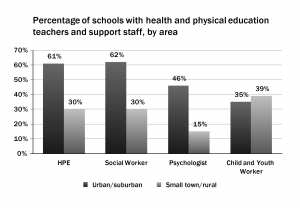Health education and supports in Ontario's schools
The concept of a “healthy school” includes the social and physical environment, curriculum teaching and learning, healthy school policy, and student engagement; as well as home, school and community partnerships and services.
A number of Ministry policies have been introduced to improve students’ overall health. This focus on health is reflected in an upward trend in the percentage of Ontario elementary schools with a health and physical education teacher.
Data from People for Education’s Annual Report shows that in 2016:
- 48% of elementary schools report having a health and physical education teacher, either full- or part-time, compared to 40% in 2009
Student mental health and well-being are also at the forefront of Ministry policy. Data from the 2016 annual report shows that:
- 50% of elementary and 76% of secondary schools report having a regularly scheduled social worker, compared to 43% of elementary and 63% of secondary schools in 2012.
- 37% of elementary and 53% of secondary schools report having a regularly scheduled child and youth worker, compared to 33% of elementary and 51% of secondary schools in 2012.
Although this year’s report shows an overall improvement in access to staff that help support students’ physical and mental health, schools in rural areas and small towns are less likely to have access to these specialists than their urban/suburban counterparts:
-
61% of urban/suburban elementary schools have a health and physical education teacher, compared to 30% of small town/rural schools.
- 62% of urban/suburban elementary schools report regularly scheduled social workers, compared to 30% of small town/rural schools.
- 46% of urban/suburban elementary schools have a regularly scheduled psychologist, compared to 15% of small town/rural schools.
Read the Health chapter from the 2016 annual report on schools.

